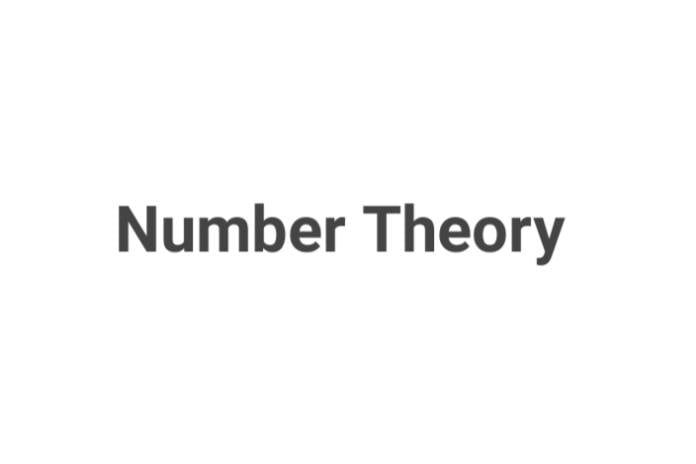Solve Number Theory Mcqs | Number Theory Mcqs with solution

26. If a = bq + r, then which of the following is true?
A. (a, b) = (b, r)
B. (a, r) = (b, r)
C. < a, b >=< b, r >
D. < a, r >=< b, r >
27. For any two non zero integers a, b, we have (a,(a, b))=
A. b
B. a
C. ab
D. a + b 28. Let a, b be non zero integers and c ∈ Z, the equation ax + by = c is called … in two variables.
A. Polynomial
B. Linear Diophantine
C. Linear Equation
D. Quadratic
29. Let d = (a, b). The Linear Diophantine equation ax + by = c has a solution if and only
if:
A. d|c
B. c|d
C. (c, d) = 1
D. c|(a + b)
31. A point (xo, yo) with integral coordinates is called:
A. Common point
B. Lattice point
C. Integral point
D. None o 32. A number n whose only positive divisors are 1 and n, is called:
A. Prime
B. Coprime
C. Relatively prime
D. All of these
33. The smallest prime number is:
A. 1
B. 2
C. 3
D. 5
34. An integer which is not a prime, nor composite is:
A. 1
B. 2
C. 3
D. 4
35. Every integer n > 1 has a:
A. Prime divisor
B. Composite divisor
C. Common multiple
D. Both A and C
36. If p is a prime and p|ab, then
A. p|a or p|b
B. p|a and p|b
C. Both a and b
D. nothing
37. There are … number of primes. (Euclid’s theorem)
A. Finite
B. Infinite
C. Countable
D. None of these
38. Let n > 1 be a composite number, then there exists a prime p such that p|n and
A. p ≤√n
B. p ≥√n
C. p < √n
D. p > √n
39. Every integer n > 1 can be represented uniquely as a product of:
A. Prime numbers
B. Composite numbers
C. Even numbers
D. Odd numbers
40. For n > 0, the numbers of the form 22
n+ 1 are called … numbers.
A. Fermat
B. Mersenne
C. Perfect
D. None of these
41. Any two Fermat numbers are:
A. Prime
B. Coprime
C. Composite
D. None of these
42. For n > 0, the numbers of the form Mn = 2n -1 are called:
A. Fermat’s
B. Mersenne
C. Perfect
D. None of these
43. If Mn is prime, then n is:
A. Prime
B. Composite
C. Not necessarily prime
D. Not necessarily composite
44. Given a positive integer n, τ (n) or d(n) denotes the:
A. Sum of positive divisors of n
B. Number of positive divisors of n
C. Number of coprime numbers of n
D. None of these
45. Given a positive integer n, σ(n) denotes the:
A. Sum of positive divisors of n
B. Number of positive divisors of n
C. Number of coprime numbers of n
D. None of these
46. If n is a positive integer such that σ(n) = 2n, then n is called a … number.
A. Mersenne
B. Fermat
C. Perfect
D. None of these
47. Let m be a fixed positive integer. Then an integer a is congruent to an integer b modulo m, written as a ≡ b(mod m) if:
A. a|(m + b)
B. m|(a a b)
C. m|(b b a)
D. Both B and C
48. Congruence is … relation on Z.
A. Equivalence
B. Partial order
C. Anti symmetric
D. Anti reflexive
49. Let a, b ∈ Z. Then a ≡ b(mod m) if and only if a, b have the same … after division by m.
A. Quotient
B. Remainder
C. Both A and B
D. None of these
50. If a ≡ b(mod m) and c ≡ d(mod m), then which of the following is false?
A. a + c ≡ b + d(mod m)
B. ac ≡ bd(mod m)
C. na ≡ nb(mod m), where n ∈ Z
D. None of these
51. φ(n) = n n 1 if and only if n is:
A. Prime
B. Odd prime
C. Odd
D. Even
52. (p √ 1)! ≡ −1(mod p) if and only if
A. p is a prime
B. p is an odd prime
C. p is an odd integer
D. None of these
53. For a, m ∈ Z, a
φ(m) ≡ 1(mod m) if
A. (a, m) ≠ 1
B. (a, m) = 1
C. < a, m ≠ 1
D. < a, m >= 1
